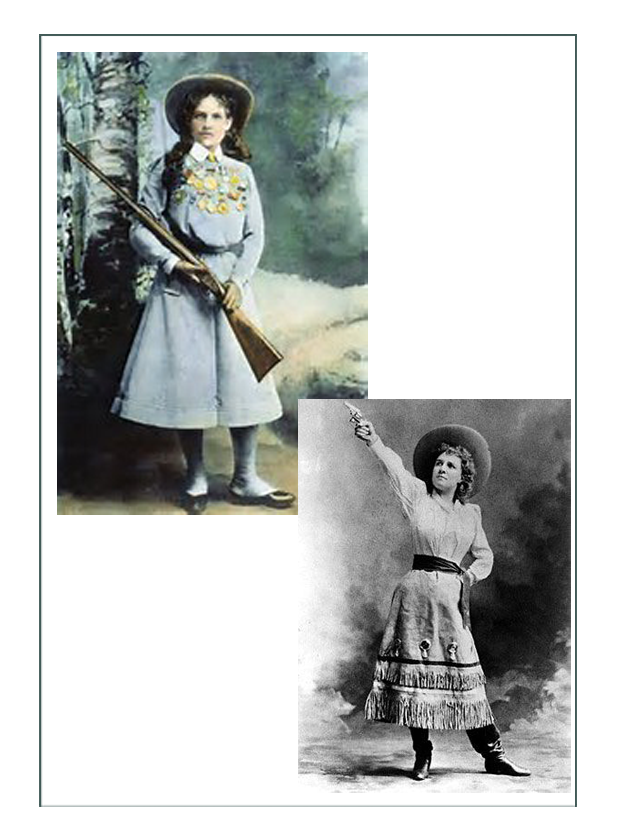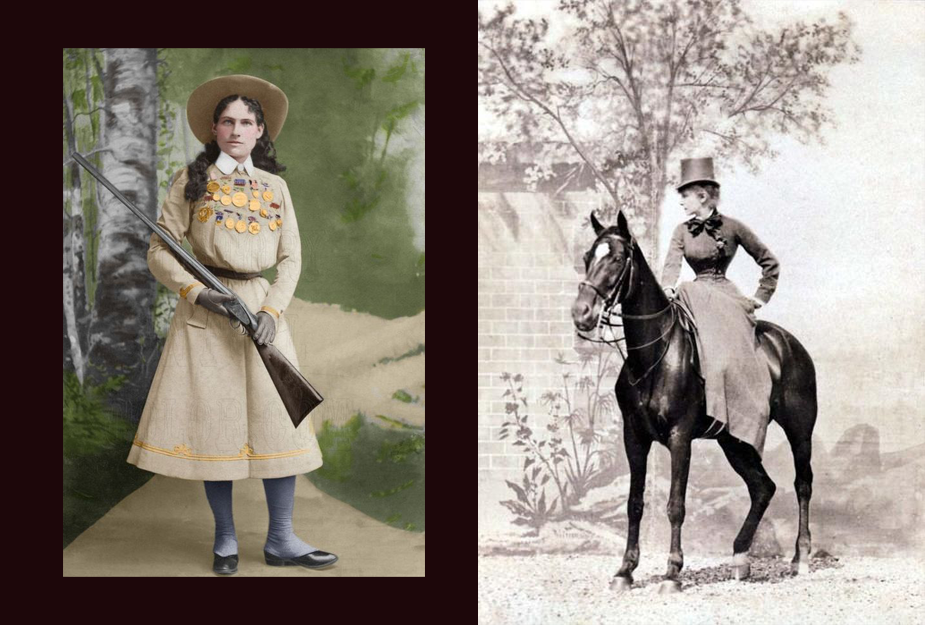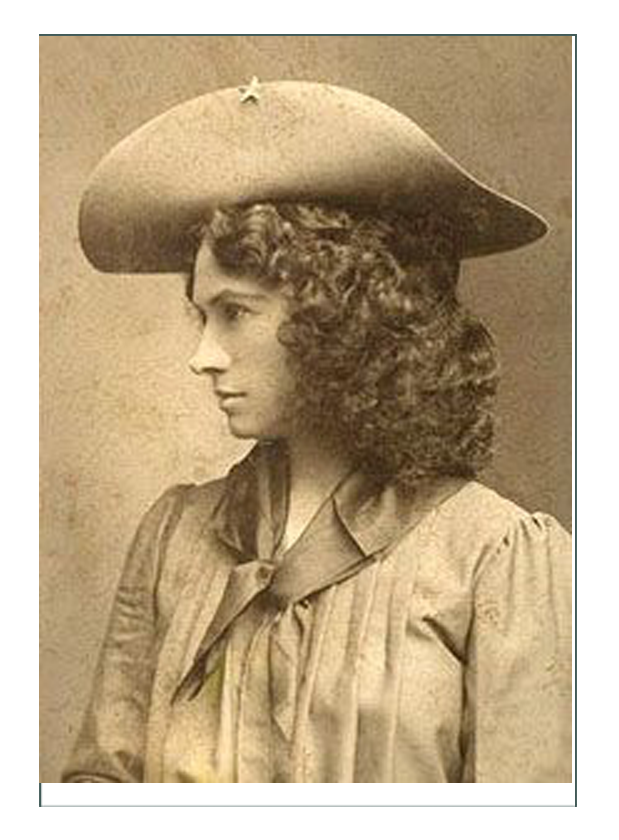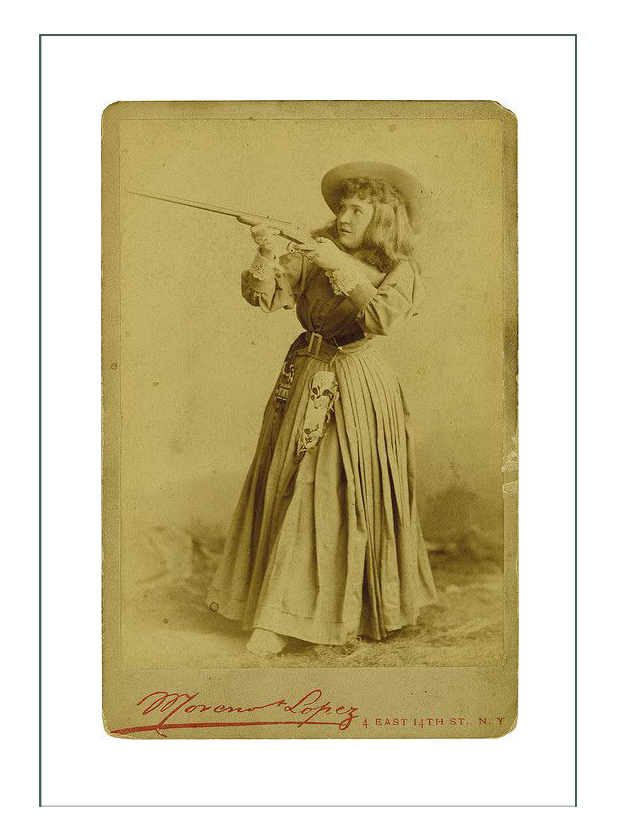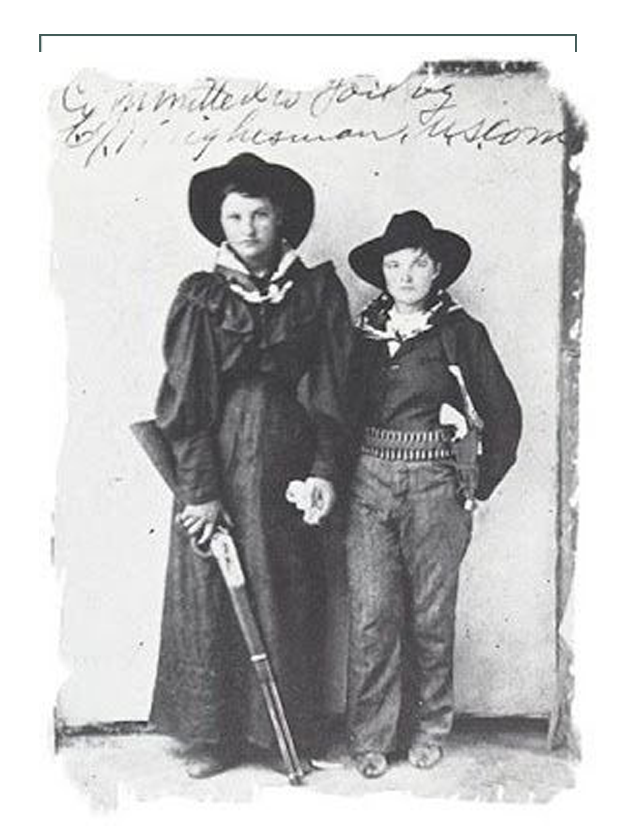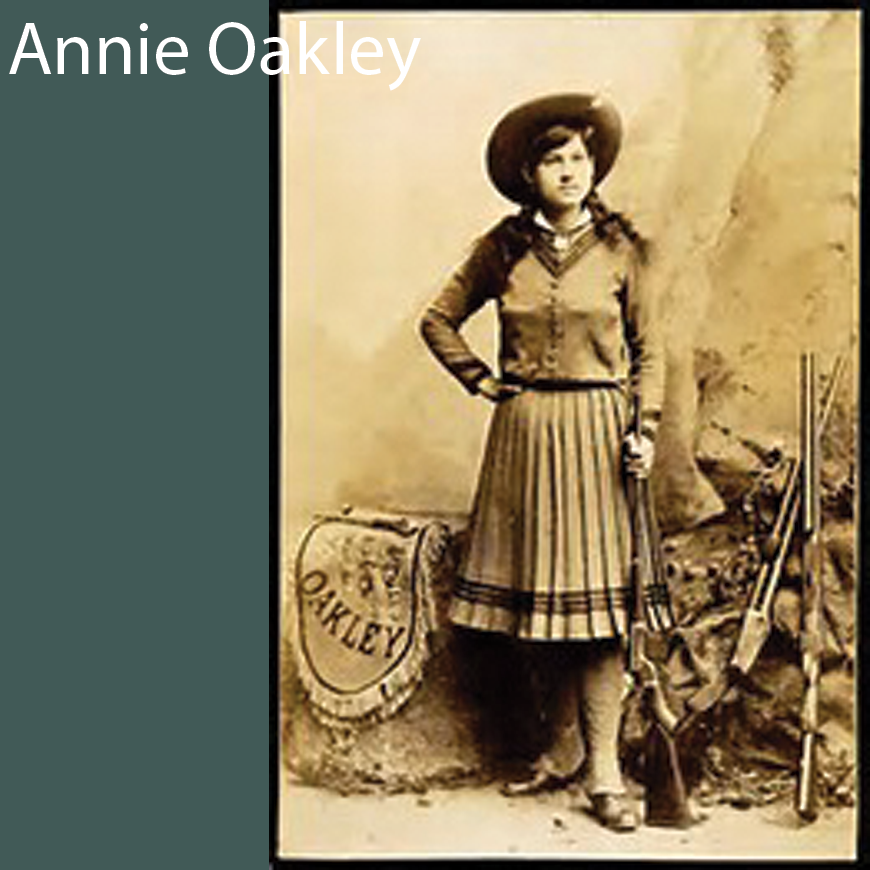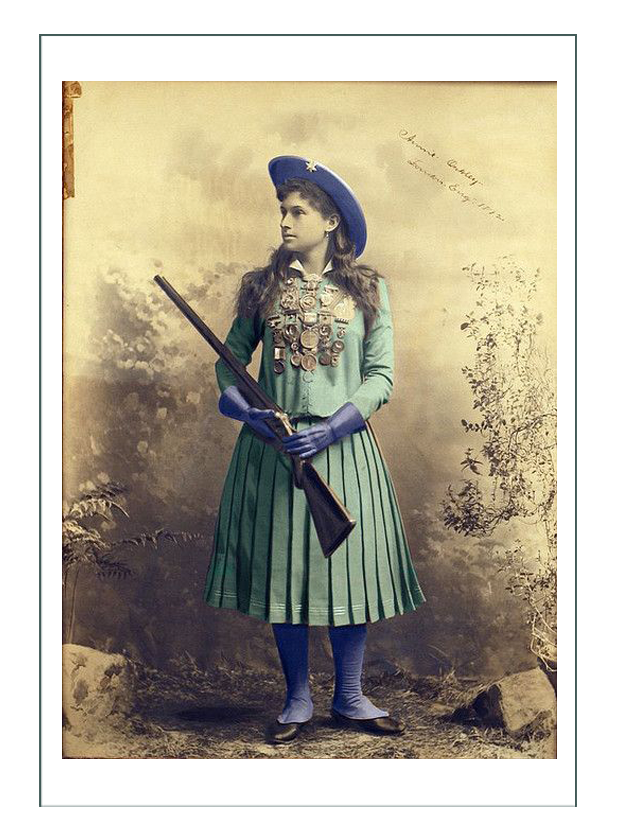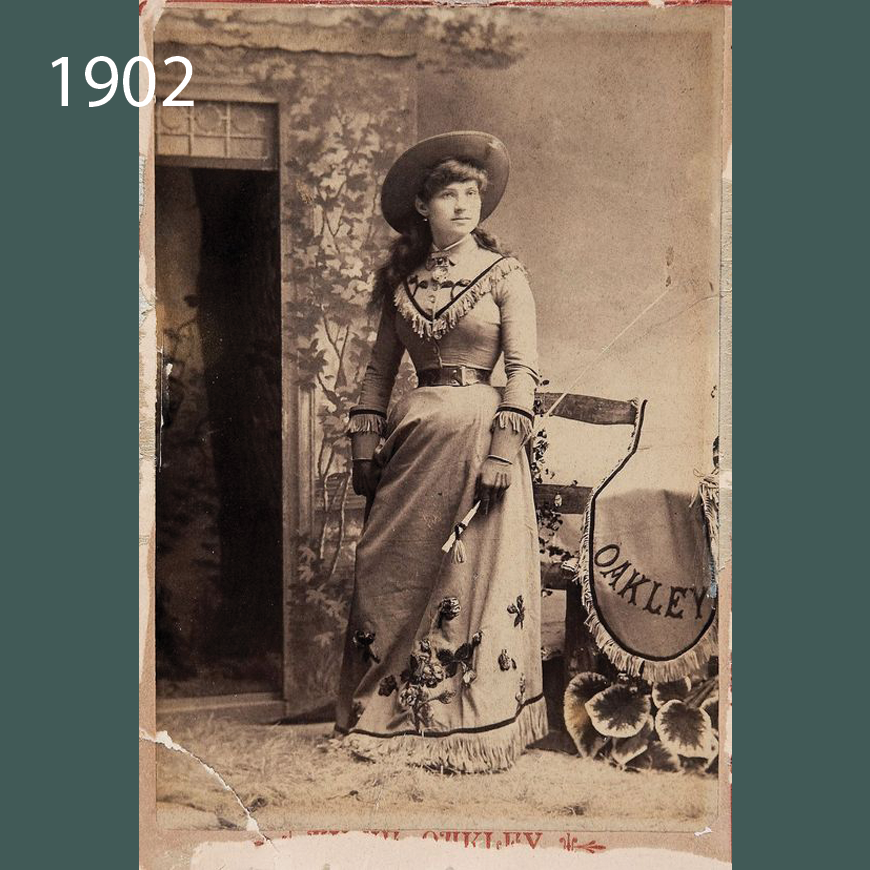
1840-1915 Western Fashion in General
—— THE ERA IN BRIEF ——
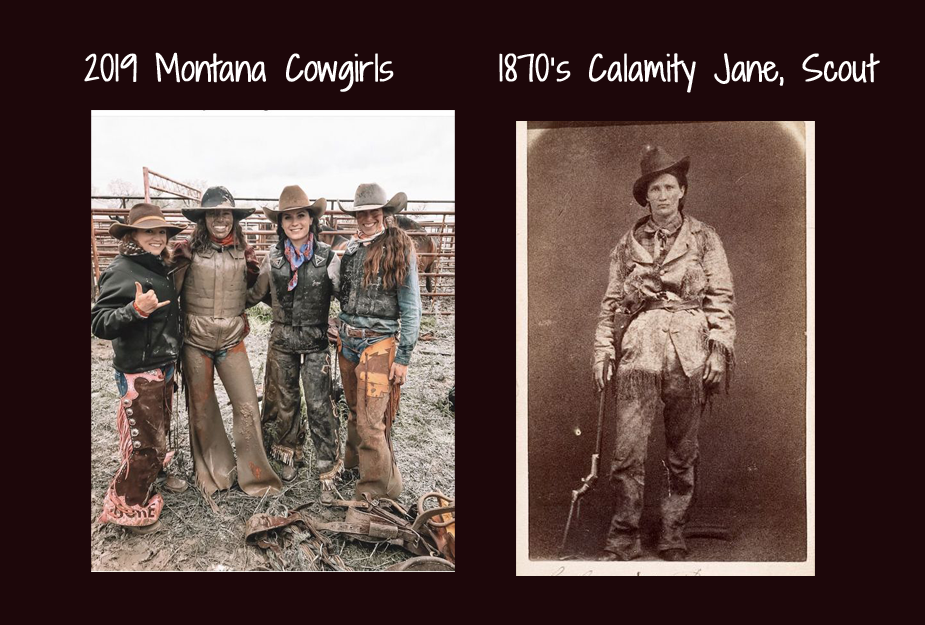
Women of the American Old West had to be resourceful to cope with the elements that surrounded them: the harsh conditions, lawlessness, & living in an age where there were few amenities. Some women took to the gun as readily as any man, while others made lives for themselves apart from dignified society. But for women who made the trek west with their families, their lot was in raising children, running a household (that included food processing, candle & soap making, spinning, weaving, knitting, etc.), establishing schools & churches, & occasionally, warding off Indian attacks. Some were deeply involved in human & voting rights (the suffragette movement)
—— INTERESTING FACTS ABOUT THE OLD WEST ——
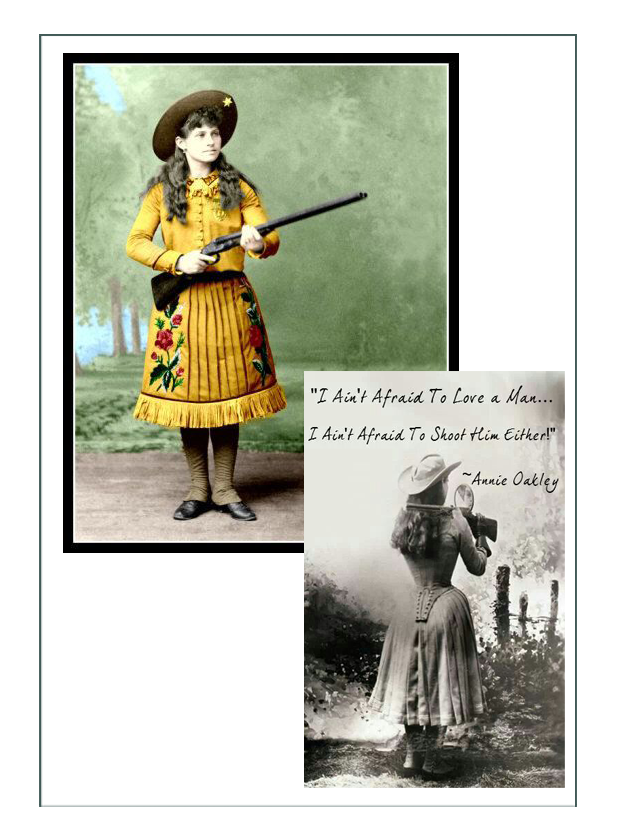
- Public performers such as singers, dancers, & sharpshooters could appear in short or split pants in the late1800’s, but it was indecent for any other women to do so
- Since there were not fashion magazines, people could only guess what was going on in the American west
- No one knew if American women created their own fashion trends, or carried those from the East
- Most women in the west were typically 2 years behind in fashion
- It was assumed Western prostitutes were dressmakers by day, and plied their trade at night
- The Stetson high crowned wide-brimmed felt hat nicknamed “The Boss of the Plains” was American born in 1876. Available in black or white so you could pick if you wanted to be the good guy or the bad guy these were worn by cowboys and cowgirls. They cost $20, about what a good cowhand earned in a month at the time. Women wore smaller versions
- Women wore denim jeans just like the men did in the West
—— WESTERN SETTLEMENT & FASHION ——
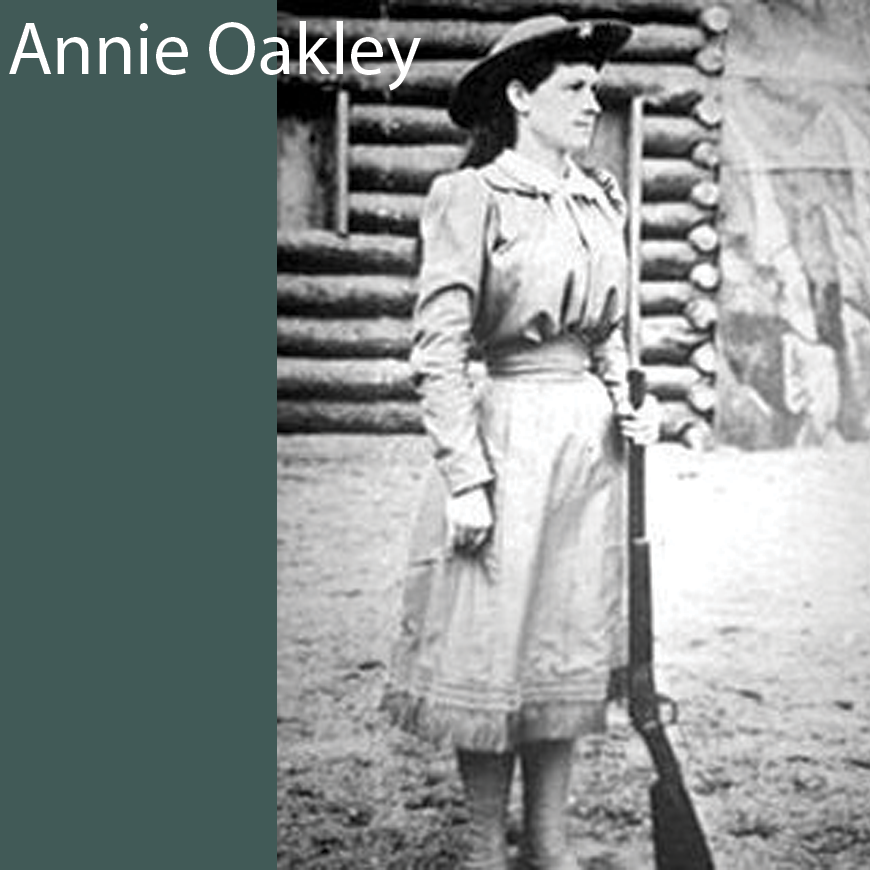
Native Americans & ancient tribes lived on the North American continent long before Europeans & eventually others from around the world emigrated to the continent to build what would become the United States of America. The Mayflower brought the Puritans in the 1640’s.
The next “wave” of immigrant women into America was in the early 1700’s – more specifically the 1730’s-1740’s during political & economical strife in Scotland & England. The English, holding “ownership” of the American colonies at the time, predominated settlement in the east. (Along with the French to the north and the Spanish in the south). For this reason, most early women settlers & immigrants were of European descent.
There were two subsequent large European migrations after that; the first to the east coast, & the second of more direct affect to settlement of the “West”. In the 1880’s women from Germany & the Netherlands came down the Great Lakes to land in what is now Chicago. Some went south towards Missouri & Kentucky, but most settled nearby in the Midwest.
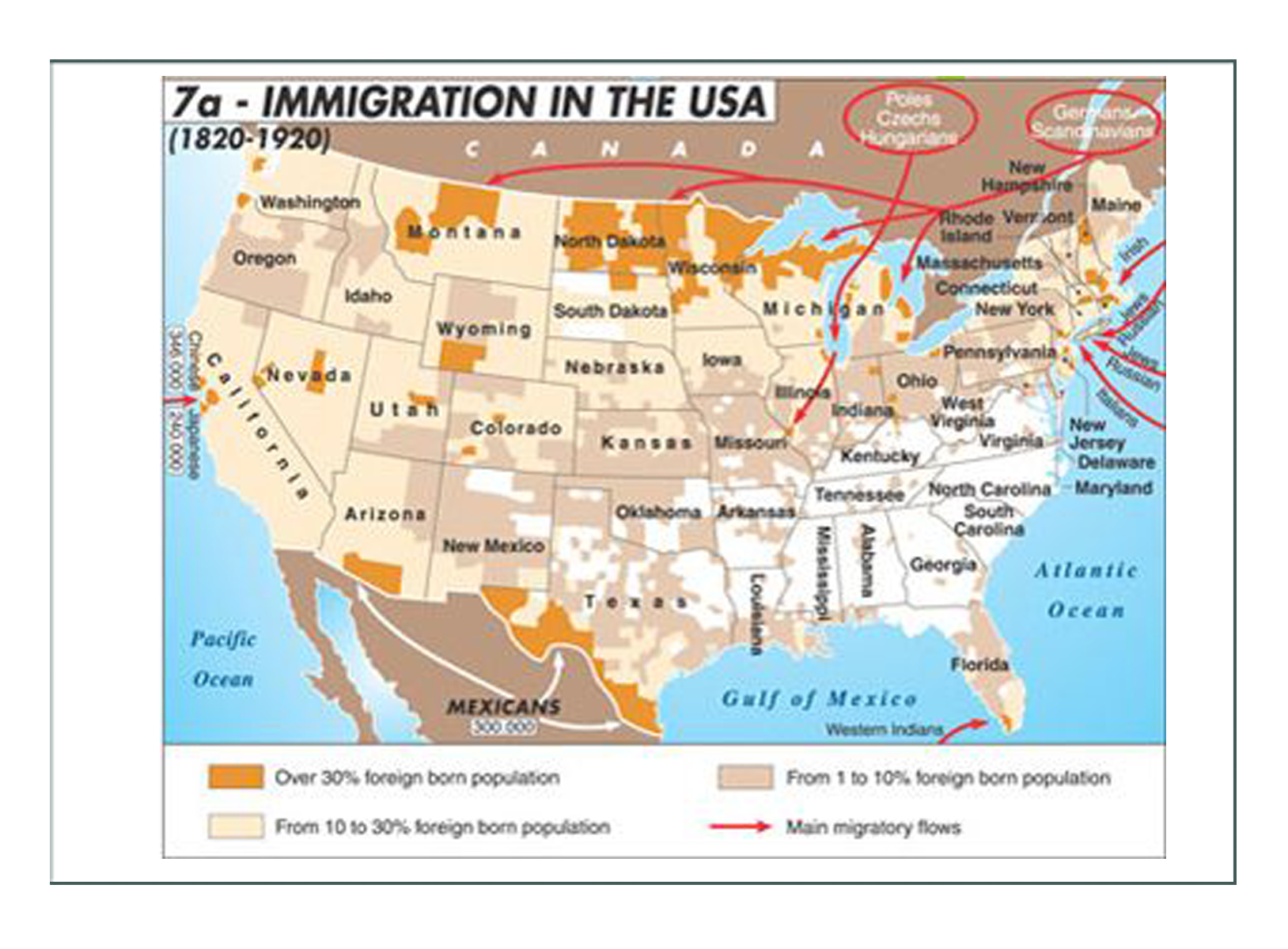
Midwesterners from what is now Michigan, Wisconsin, Minnesota, Iowa, & Illinois were among the great numbers that continued to move on westward in the 1880’s & early 1900’s. By 1862 when the first Homestead Act offered 160 acres in what would become Montana & Wyoming to anyone who would live there for 3 years, people jumped at the chance whether they knew anything about ranching or not. Iowa had run out of farmland for their 3rd or 4th sons. By 1910, when the government offered 320 acres instead, settlement began in earnest (& in Wyoming).
It was at about that same 1870-1910 time period that religious groups such as the Mormons traveled West. Many of these groups, including the Irish & Chinese who came to work on the railroads, were often staying temporarily or just moving through the West to get to California & Pacific coastal regions. Those of many different cultures did stay, although documentation of their influence on fashion is difficult to find.
When history talks about “Old West”, it refers to geographical regions west of the Mississippi River, north to the Canada border, south to Mexico, & west to the Rocky Mountains. Nebraska, Kansas, the Dakotas & anything west of the Mississippi River was still considered to be the “Old West” or the “Wild West”. Iowa & Missouri, sitting on the Mississippi, were “West” too.
There were relatively few women of European descent west of the Mississippi prior to the 1830’s that can be tracked for fashion trends, & assumption can be made that in the years 1840-1914, women were predominantly of European descent, regardless of skin color. Until the common usage of the camera in the late 1840’s, little was recorded of what women were doing (& wearing) from the Mississippi westward.
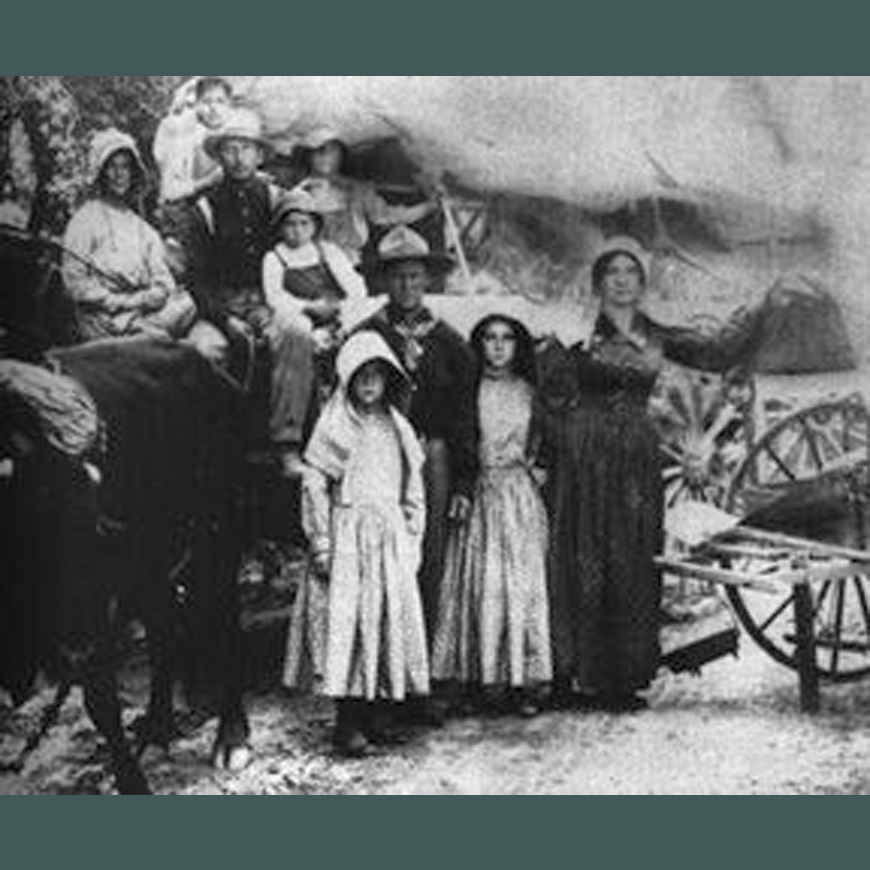
“West” seems to mean the legends & tales of the time from 1840-1915 – from when the first Europeans arrived in some force to the advent of World War I. It’s considered to have been the time & place of cattle, outlaws, trains, & bordellos. The challenge is to get behind that to find out what real & “regular” people were doing & wearing.
The only firmly recorded history seems to be of of prostitutes & fallen women who fell on the profession of necessity to survive, or followed the gold rush of 1849. There is record of outlaws & cattle women, but usually in papers outlining something terrible that happened. Land records of Homesteading & business ownership document some facts. Mostly, we must rely on verbal stories, legends, diaries, periodicals, or artifacts to under the lives – and clothing – of the pioneer women of the 1840’s to 1860’s before the railroad became the means of crossing the country starting in the 1870’s with completion of the transcontinental railroad in 1869.
For purposes of our depictions we begin with the advent of the camera in 1840. Prior to that, we must make assumptions based on paintings & sketches of artists who explored the West, or draw conclusions based on observations about history & emigration; the movement of ideas & materials from one place to another.
Before 1890, only women who performed in public such as dancers, shooters, or other artists could get away with wearing short or split skirts. Any other woman would create a scandal and be ostracized by society.
—— FEW FACTS & A LOT OF FIGURING ——
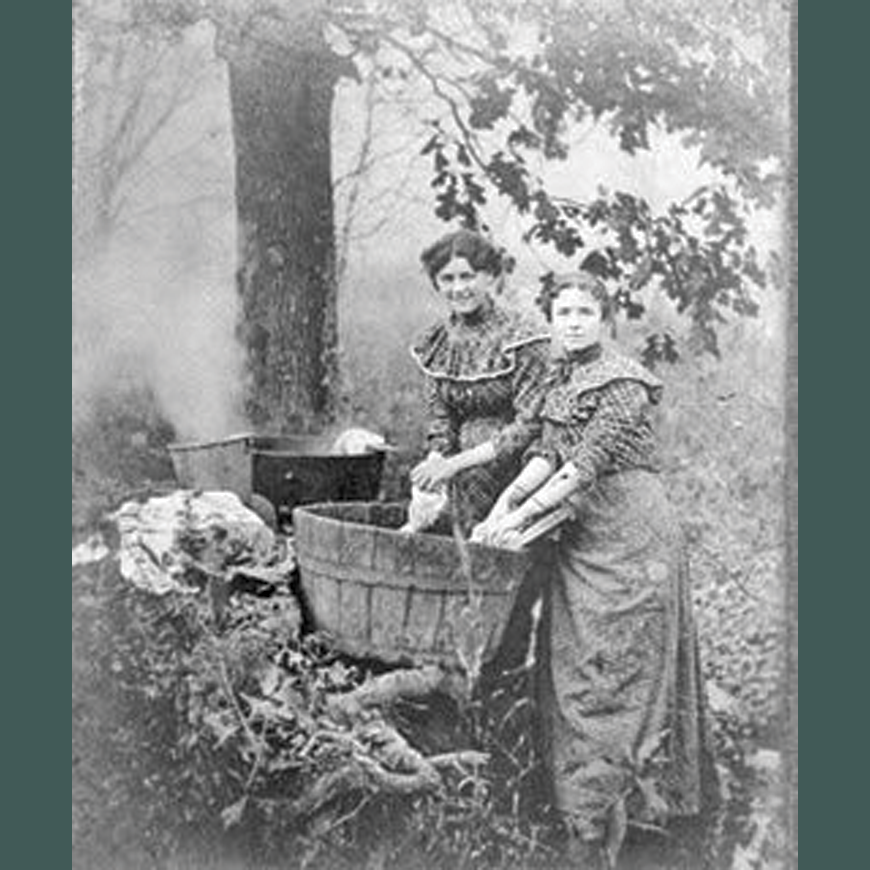
Fashion of the Old West is based on (in this order): real articles of clothing, photographs, portraits, paintings by Western artists, sketches, journals such as explorers or land records, obituaries, diaries, newspapers, magazines, notes in Bibles property ownership records, word of mouth, stories, & legends. Some, like the record of how many dresses a woman left in her will, are accurate. Others, like the story handed down by your great-grandmother or the story of Calamity Jane & General Custer, have to be interpreted.
Design & depiction of fashion of Western America fashion must put all those odds & ends together, along with what is known about influences, environment, availability, attitudes, culture, values, & assumptions about the person or people being studied & depicted. There are whole professions, notably Anthropology, which study these factors. Yet other professionals such as Museum Curators spend whole lifetimes gathering & studying the clues of fashion.
For our purposes for depiction, we must trust the research of those professionals, & draw the best conclusions we can based on which facts are known, but add Grandma’s stories to breathe life into our depictions. Our projects will assume fashion for depiction is based on one of the factors below.
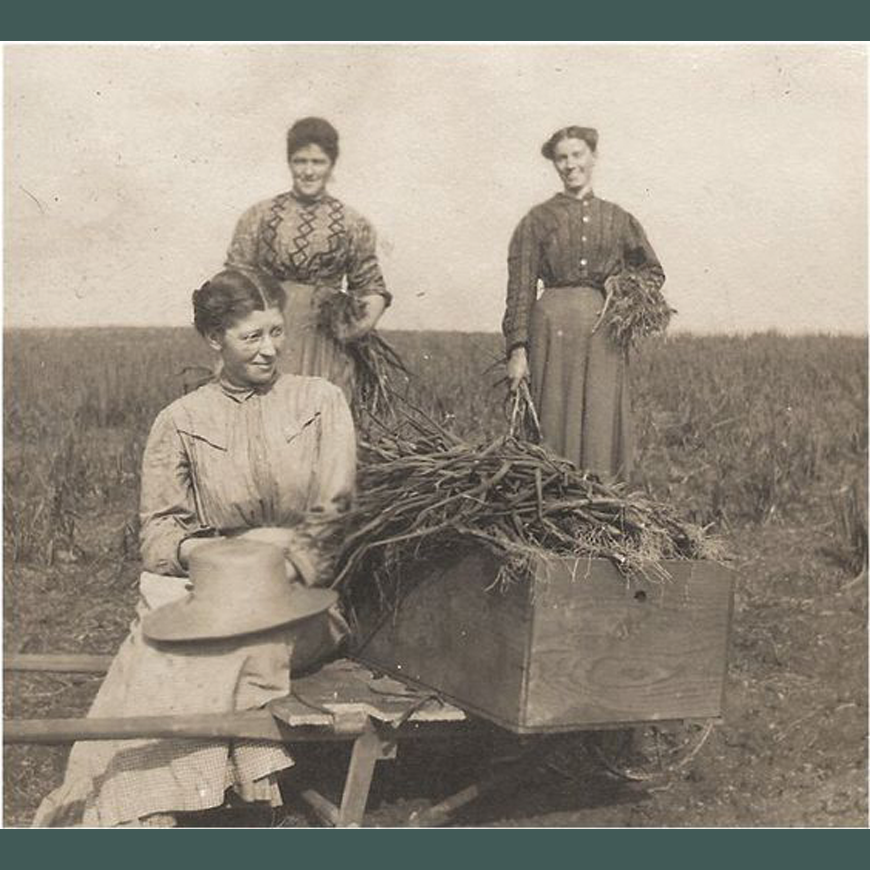
- A) Fashion and/or the concept of fashion of the day was physically carried from the east coast (originating from the same influences as Easterners), & then modified or adapted to suit the culture, time, place, or activity;
This starts with the assumption whatever the current trend of the east is being carried west, & will focus on those factors which would cause them to be modified; e.g. materials, patterns, or communication unavailable;
It means fashion will almost always be 1 or 2 years out of style compared to the east. Designs based on this assumption will end up being modifications of whatever was in style in the east a couple of years prior to the depiction.
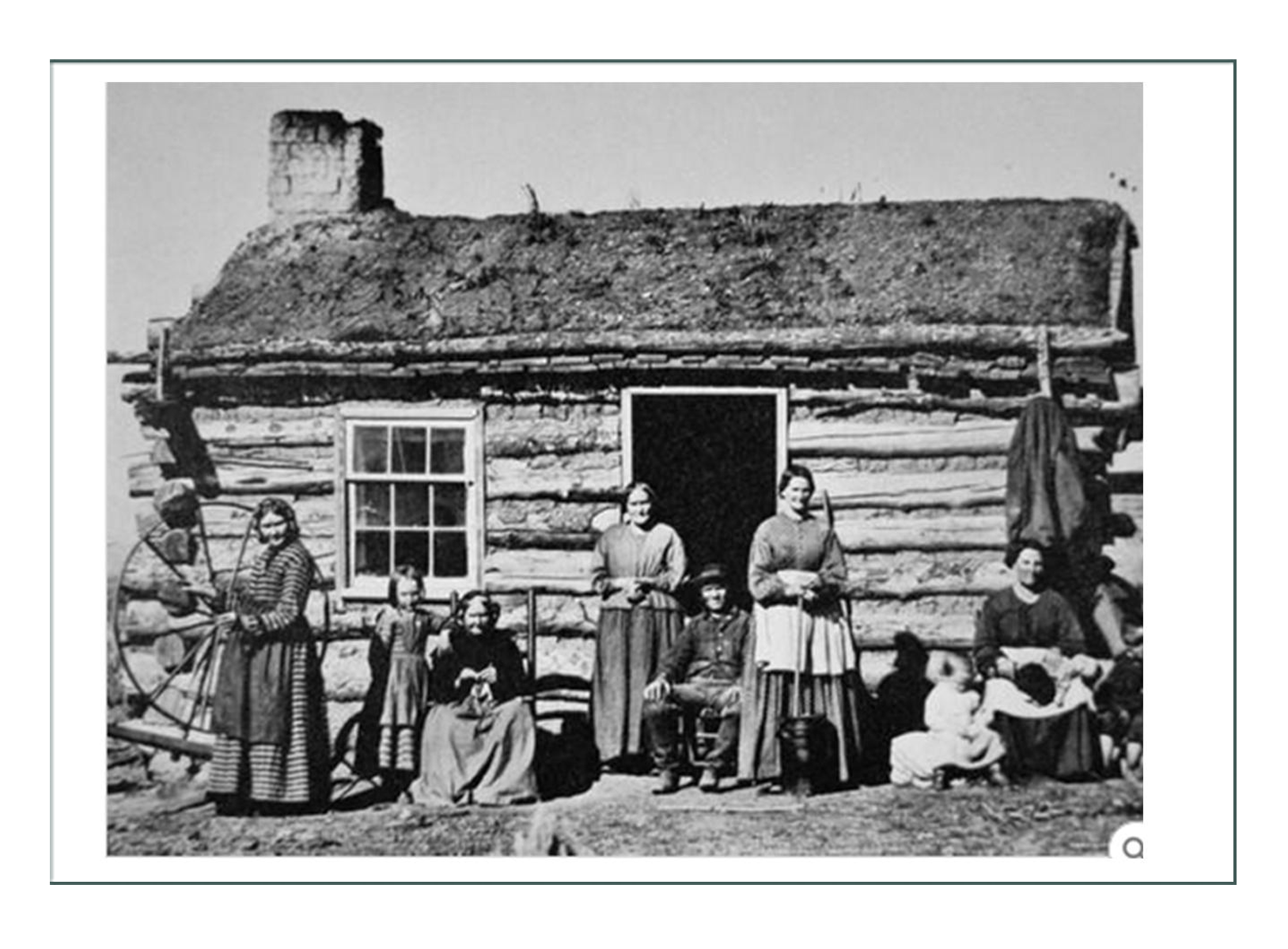
- B) Clothing was origined out of local materials; e.g. furs, leathers, & therefore based on the same influences as men’s fashion such as evolution of the cowboy ensemble, almost strictly for function;
These projects will be researched & developed per project by specific region, working with our subcontractors who specialize in indigenous materials. The American Cowgirl in particular demands research into male clothing & its adaptation for women.
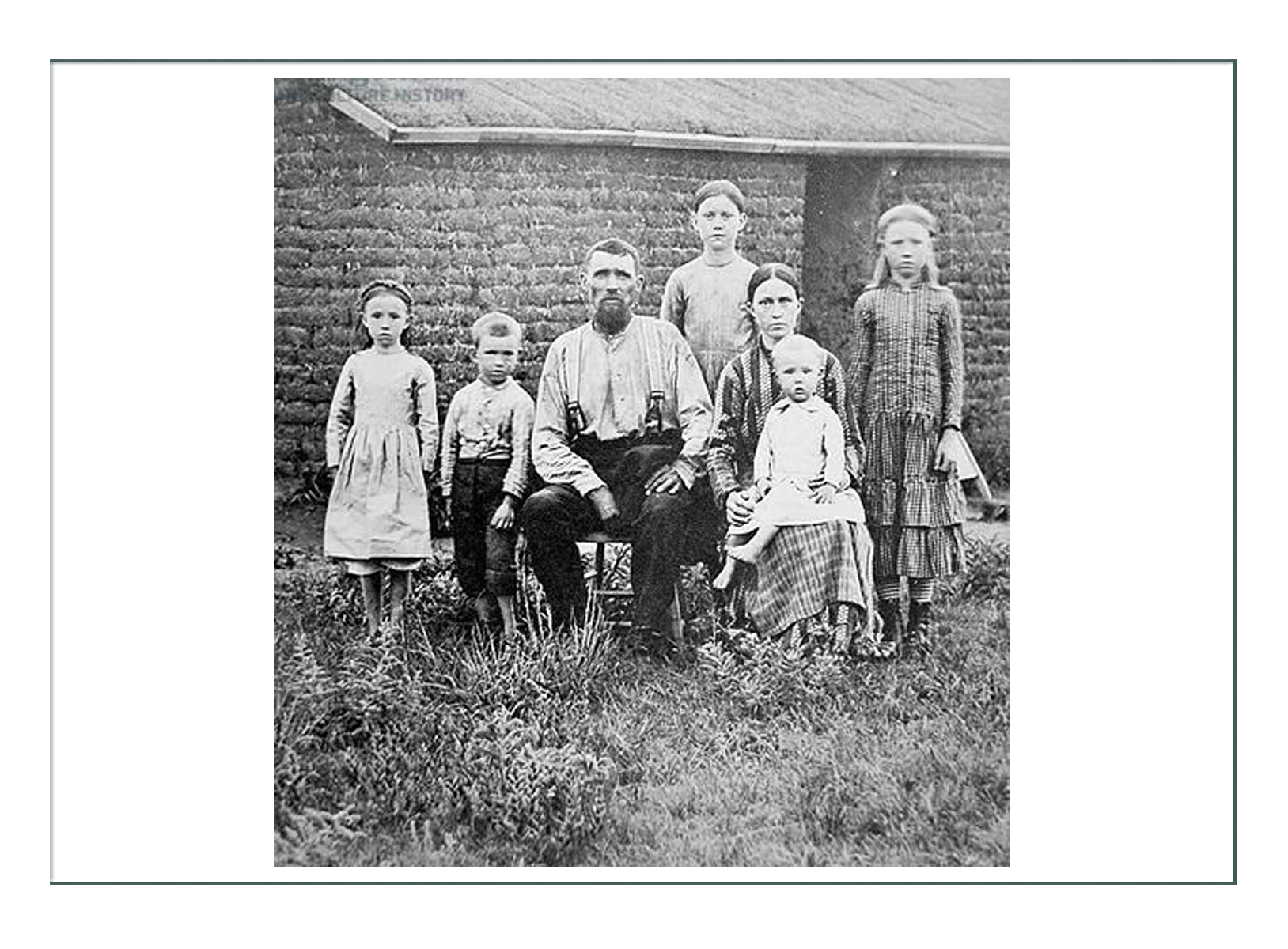
- C) Fashion design & clothing was a combination of above; e.g. western innovations like denim jeans which arise out of functional need; yet using modern technology of fabric, dye, & production that comes from the east which combines local availability of fur, skin, or locally made fabrics or materials (such as spun or woven yarn) with those of mass production or import;
This will be the result of very specific character of research, since it combines extensive historical data as to fashion of the day PLUS the specific geographic region including all aspects of the time & place;
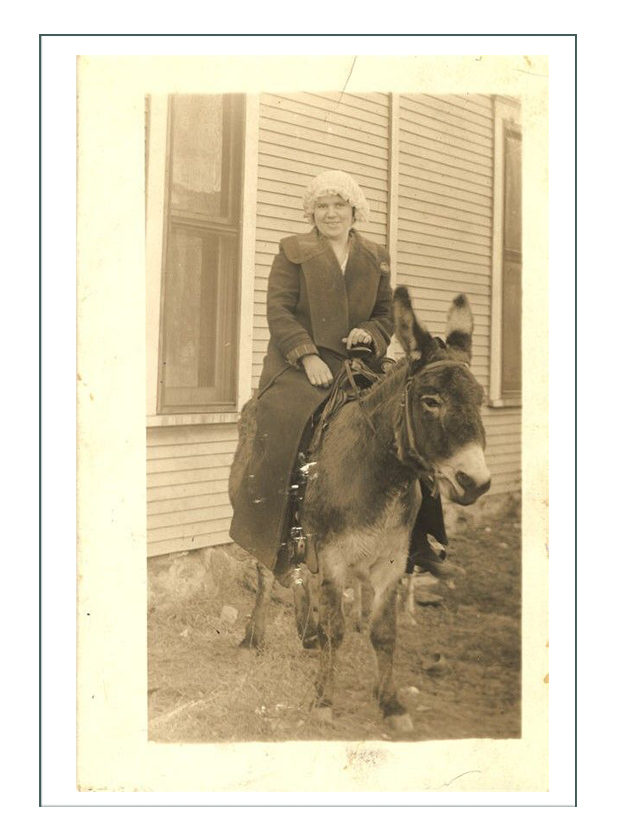
- D) Design & construction of garments comes of native, ancient civilization inspiration, influence, or actual use;
Silhouettes intentionally choses not to develop “D”, as the world of ancient & Indian cultures is vast & complex, & can take a lifetime, although influences of such will be considered with characters where that is pertinent.
—— WYOMING WOMEN OF INFLUENCE ——
(The “social outlaws”)
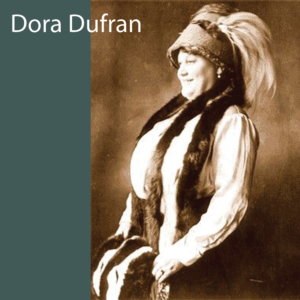
- Dora DuFran (aka “Amy Helen Bolshaw”): was born in England & came to America around 1869 to settle in New Jersey. She was extremely good looking & became a prostitute at age 13-14. soon after she became a dance hall girl, calling herself Amy Helen Bolshaw. When the gold rush hit, “Amy” moved to Deadwood, South Dakota at age 15 & promoted herself as a Madame & began operating a brothel. She preferred to have very pretty girls work for her, but the selection in the west was very limited, so she satisfied herself that her girls were clean & healthy & demanded they practice good hygiene & dress well.
Dora (now called “Dora” again) picked up several girls who arrived in Deadwood via a wagon train led by Charlie Utter. Dora is credited with coining the term “cathouse” after Charlie brought her a wagon of cats for her brothel to clean up the mice.
Calamity Jane worked for her (“Martha Jane Burke”); her main competition was a deadwood Madame Mollie Johnson. She had several brothels over the years; most popular being “Diddlin’ Dora’s” in Belle Fource, SD which advertised itself as the “Three D’s – Dining, Drinking, & Dancing – a place where you can bring your mother”. Cowboys who visited the place responded by stating “I wouldn’t want my mother to know I had ever been there.”
Dora’s other brothels were in Lead, Miles City, & Sturgis SD or MT. She was a successful brother owner until the day she died.
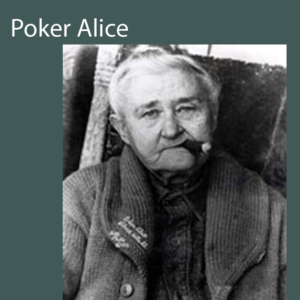
- Alice Ivers “Poker Alice”: born in England but her family moved to Colorado where her husband Frank Duffield, a mining engineer taught her how to play poker. After Frank was killed in a mining accident, she had to support herself & turned to card game gambling. She expanded her operation all over the west into 6 states. In Deadwood, SD, she became legendary for her ability to attract lots of men to the table where her deadpan poker face gave her a distinct advantage over all of them.
Alice met her 2nd husband Warren G. Tubbs in Deadwood when she beat him at the game. That didn’t matter to Tubbs because he earned a living off of selling paintings. At Tubb’s death, Alice & her 2 sons became marauders in the swamps of Louisiana during the Civil War. When she returned home, soldiers almost captured her, so she ran to Wyoming to re-establish her gambling enterprise which included hiding gold & money for stagecoach robbers. When things got dangerous there, she moved to Sturgis, WY & began playing poker & running a bordello. Her beauty had faded, so she dressed & acted as a cigar smoking man.
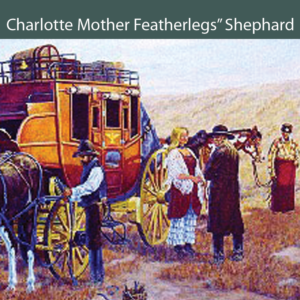
- Charlotte “Mother Featherlegs” Shephard: ran a roadhouse bordello on the Deadwood Trail near Lusk, Wyoming. She provided whiskey & comfort to travelers on their way to the Black Hills gold fields around 1876, & associated with dangerous outlaws. Partnered with one such man who eventually shot her dead on the trail, she was known for riding astride a horse at full speed across the prairie with the ruffles from her red pantalettes flying in the wind so that she looked like she had chicken feathers.
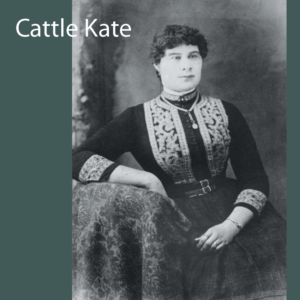
- Ellen Liddy Watson “Cattle Kate”: female pioneer of Wyoming & an outlaw although she was never charged with a crime. The eldest of 10 children the family lived to Kansas in 1877. At age 16, Ella married a man who was abusive, drank heavily, & beat her with a horse whip.Fleeing from him, she moved to Denver, CO to live with a brother, where she found work as a seamstress & cook.Bravely moving out on her own, unheard of for most women of that time, she worked as a cook in Rawlins, WY for the premier boarding “Rawlins House”.
Some allege it was a brothel & that she was a prostitute. James Averell, a local rancher who had recently lost his wife & child, met her at the roadhouse & brought her home to his “road ranch” near Lander, WY.With her divorce finally legal in 1886, she may have married Averell, but records show she filed independently on a homestead next to his & built her own 2 room cabin.
Law of the time stated any unbranded calves found on a property were to be branded with an “M”, which would become the property of the Stock Growers Association, a huge political & police type force at the time.The Association’s goal was to shut down small ranchers.Kate’s neighbors who belonged to the Assocation claimed her land was theirs already, & that she had marked lost steers with her own brand instead of the “M”.
Averell, being the local Justice of the Peace wrote newspaper articles to expose the Association’s scam. Ella became known in media as “Cattle Kate”, & under pressure from small ranchers, the Governor changed the law to their favor., but it was too late. A lynch mob, never proven but highly suspected to be the Association neighbor hung Averell & Ella during a shoot out between opposing factions, which was the start of the Johnson County War.
—— NOTABLE WESTERN “OUTLAW” WOMEN (other than Wyoming) 1840-1914 ——
(note how they are all shown in high fashion of the date, not for the most part – men’s clothing nor riding skirts)
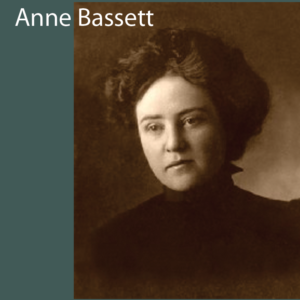
- Anne Bassett: friend of Etta Place & the Sundance Kid of outlaw fame. She was a rancher turned cattle rustler, & thought to have been actively participating with the Wild Bunch gang, but it was never proven so.
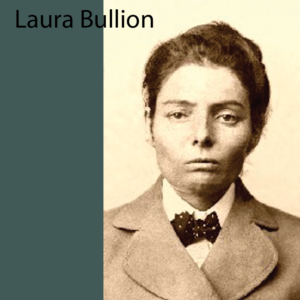
-
- Laura Bullion aka “Della Rose”, “Rose of the Wild Bunch” of Texas: daughter of a German mother & a Native American bank robber father. She was associating with outlaws from a very early age. At 15 she fell in love with her aunt’s husband Will Carver, who worked with Black Jack Ketchum robbing trains in Utah. Rose & Black Jack joined with Butch Cassidy & the Wild bunch where her job with the gang was to fence the goods taken from train robberies. When Butch & Sundance disappeared & the gang broke up, she lived as a dressmaker under the name Freda Lincoln until the end of her life.
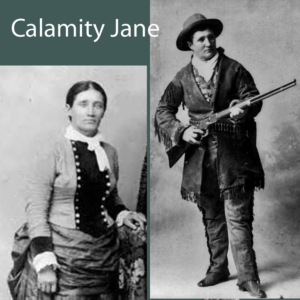
- Martha Jane Canary “Calamity Jane”: dressed like a man & was known for being tough. By the time she was 18 after the Civil War, she had been a nurse, dishwasher, waitress, cook, & ox-team driver. Being responsible for her siblings at her parents’ death, & having no formal education, she was still being extremely smart, talented, & literate. She moved the family to Montana so she could become a soldier. From that point on her life was very colorful, but historians claim she exaggerated exploits so no one can be sure of what really happened in her life.
Calamity was a frontierswoman & professional scout for the army, & gained fame for fighting American Indians. Her associations with famous figures of the Old West had her stories claiming she served under Generals Custer & Crook. One theory of how she got her name was because as a scout she was always running into camp declaring there was trouble coming, or “courting calamity”.
Jane worked as a prostitute for Dora DuFran in Wyoming, which is where she met Wild Bill Hickok. Jane & Wild Bill were allegedly secretly married in 1870, after which he allegedly took off 3 years after the birth of their alleged daughter, but no marriage or validity was proven, although it is known she had a daughter whom she gave up to adoption.Her sharpshooting skills on a horse earned her a spot performing for Buffalo Bill’s Wild West Show in 1896, which she performed until her death in 1903.
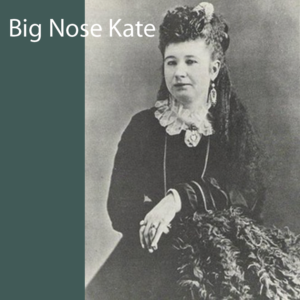
- Mary Catherine Elder Haroney “Big Nose Kate”: born in Hungary but came to America when her surgeon father was assigned to work for Maximillian the ruler of Mexico in 1862. Her family moved to Davenport, IA, but she stowed away on a steamship to St. Louis, where married & had a son. Both husband & son soon died, so in 1875 Kate moved to Wichita, KS to work in a sporting house where she met Wyatt Earp. At the time she was going by the name Kate Elder.
A few years later after a move to Texas she met Doc Holliday, Wyatt’s friend. Kate & Doc’s relationship was rough but longlasting. During the years working as a dance hall girl & prostitute she earned the name “Big Nose Kate”. She was traveling with Holliday, still working as a prostitute, when he was a part of the “Shootout at the OK Corral”.
Shortly after in 1881 when a stagecoach was robbed & Holliday was the prime suspect, she turned him in. Later she changed her mind & told them she had made it all up, & the charges were dropped.After Holliday’s death, Kate married a blacksmith in 1888 & moved to Arizona near Tombstone.
Soon after settling in, she left her husband, & moved in with a man named Howard whom she lived with until his death.
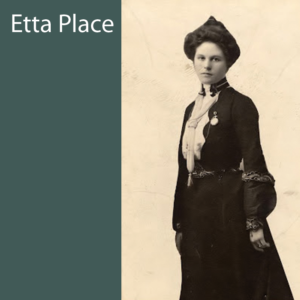
- Etta Place: went by many names & confused historians with aliases, so this name is assumed to be false too. Etta married the Sundance Kid of outlaw fame in 1899, & was thought to participate in their activities, though nothing was ever proven. She was a friend of rancher Anne Bassett who looked similar & participated in the Wild Bunch activities. The last record of her was in New York in 1903, when Butch Cassidy & the “Kid” bought her some jewelry then left for South America.
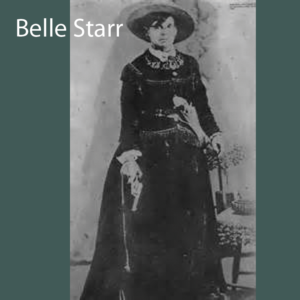
- Myra Belle Shirley “Belle Star”: part of the famous Hatfield & McCoy feuding families of Missouri. She moved to Texas when Confederates burned down her town in the Civil War. She excelled at the arts & higher education; particularly playing the piano well.
Acting as a union spy during the Civil War, she made friends with Quantrill’s guerillas who were friends with Jesse & Frank James who had turned to armed robbery after the war. In flight from lawmen, friends of the James & other outlaws would hide out at her farm.Belle married one of the outlaws who had fallen in with the Starr clan; a Cherokee Indian family notorious for whiskey, cattle, & horse thieving.
After her husband committed a murder, the whole family fled to Texas to escape the law. There her husband robbed a man of $30,000 in gold coins, & Belle was named accomplice so she & her husband went into hiding.When Belle’s husband was caught & killed by a sheriff, she took up with the Starr clan again in Indian Territory west of Fort Smith, Arkansas. There she married Samuel Starr in 1880 & completely immersed herself in outlawry as the gang leader.
Belle’s organization was very lucrative & she was able to bribe her cohorts out of prison or seduce the lawmen into looking the other way.Belle wore buckskins, moccasins, black velvet skirts, high-topped boots, a man’s Stetson with ostrich plume, & twin holstered pistols. She gambled, drank, played cards & dice, & roulette. At times she would ride through the streets shooting off her pistols, which gave her the exaggerated reputation of an outlaw.
Judge Isaac Parker “The Hanging Judge” was obsessed with bringing Belle Starr to justice & except for a brief time in jail, she continued to elude him & follow her outlaw ways. Her husband was killed by a rival, but she continued to provide legal counsel for outlaws like “Blue” Duck, a Cherokee indicted for murdering a farm hand. She was even able to get her son Ed who was arrested for horse theft off without a charge by writing a letter to President Grover Cleveland.
Belles’ end came violently after her 41st birthday when she was shot in the back by a shotgun with many suspects but no convictions. Belle Starr was a legend through the yellow journalism of her day & reinforced through dime store novels & then Hollywood.
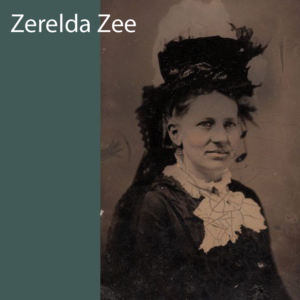
- Zerelda Amanda Mimms Zee: wife of Jesse James while the James-Younger Gang was still in full force in 1874; daughter of a pastor, & her mother was the aunt of Jesse James; they had two children survive. She was impoverished after James’ death.

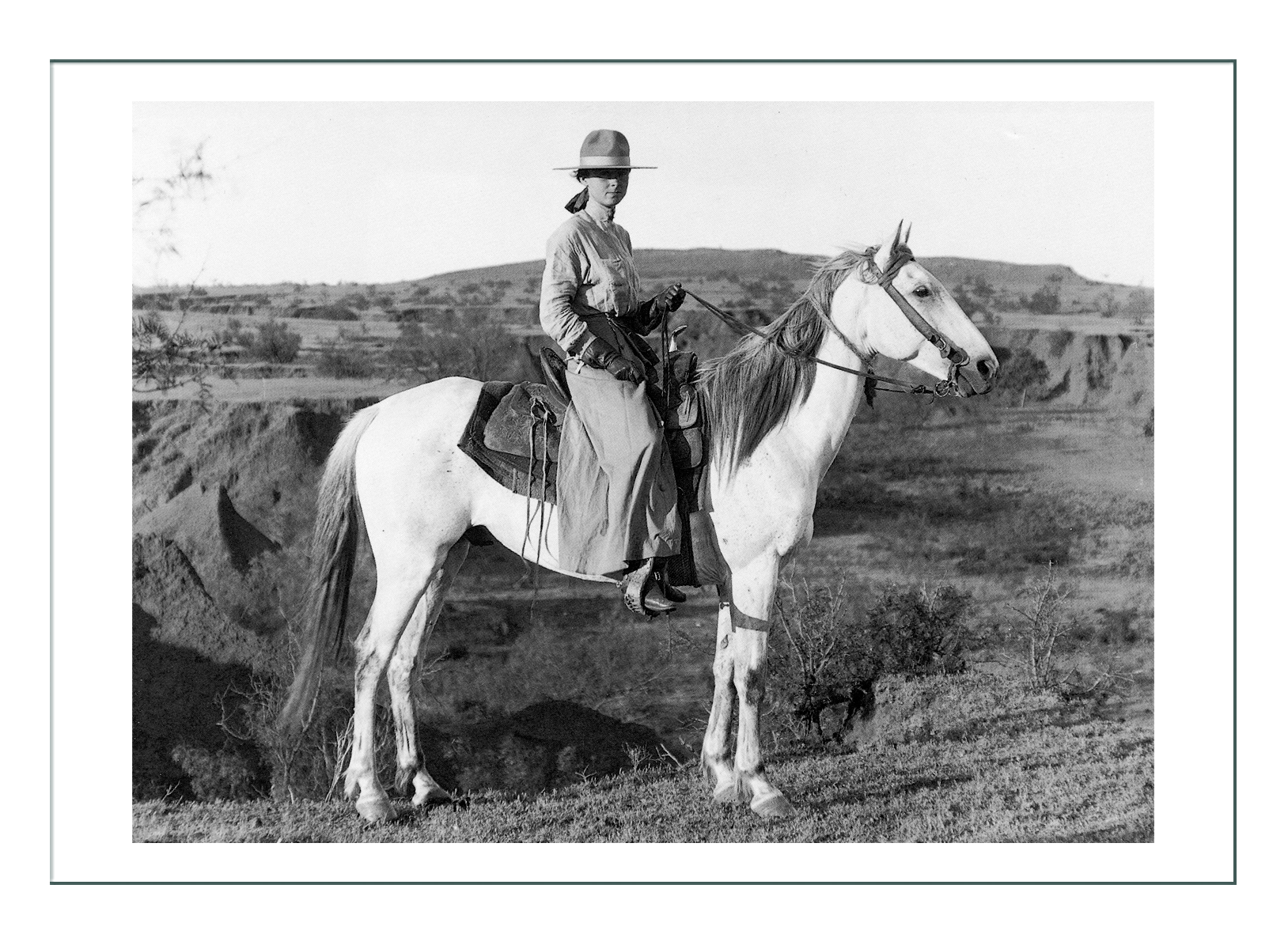
On split skirts, riding astride, and gaiters
As one studies fashion throughout history, it is consistent that the one physical activity which was ALWAYS acceptable for women of all classes and status was to ride a horse. For this reason, the history of riding habits and riding ensembles is deep and extensive.
Until about 1895 when it became acceptable for women to openly participate and compete in sports of all types, they could only ride a horse as their sport; in fact, horsemanship was considered an elite activity for women.
This translated well to the Western woman as America grew westward. Because a ranch or farm demanded so many skills and so much work, there became the first equal partnerships between men and women in the running of such.
This “function first” attitude led to the more practical and less “fashionable” garments for women of the west – but that doesn’t mean they abandoned the high fashion of the day; far from it. Even the most remote homesteader or rancher held aside what they considered “fashionable” for social events or activities where they wanted to be seen. It was only the poorest or those incapable of obtaining or making fashionable garments that could ignore societal norms for clothing for women.
Imagine today going to downtown Cody wearing a swimsuit or a pair of long johns. Both garments are perfectly acceptable during the right activity, but would probably get you thrown out of museums and restaurants. It was much the same in history.
Our theory that women wore “what they knew about, had access to, could afford, and liked” applies here entirely.

To determine what a western frontier woman – say an outlaw or rancher would wear, depends very much on who she is and what she is doing. That same woman might be entirely different in different situations. (please see the 1910 Caroline Lockhart and 1887 Homesteader project research on the website as examples and for discussions of how functional fashion vs high fashion was achieved out west. We have also extensive research on notable and western women on there in the 1840-1915 pages, as well as specifics on sports and working fashion).
The following is a nice summary of the split skirt and riding. It is from the “Laughing Moon Mercantile” who researches extant garments and builds patterns for them.
NOTE: CONSISTENT WITH SILHOUETTE’S RESEARCH, THIS EXPERT DATA AGREES THAT WOMEN, EVEN IN THE WEST, DID NOT RIDE ASTRIDE NOR WEAR SKIRTS THAT SHOWED EVEN THEIR FEET UNTIL WELL INTO THE 1890’S. Prior to that, only the rarest and bravest woman who was completely going against societal norms would have done either of those things; not even performers. You’ll note people like Annie Oakley and similar performers started only in the 1880’s, and they were young girls at the time which allowed them some societal exception. Also note – that even when the skirts are short, the legs must be entirely covered! This attitude really did not change until the 1880’s for “cowgirls” and well into the 1910’s for everyone else. The Victorian attitude that women’s feet should never be seen, which was an absolute law in the 1850’s-1870’s, still carried the attitude well until the 1910’s.
Even outlaws followed the same rules: dress to fashion when in public. Dress to perform (function) in those situations (such as robbing a bank and escaping on horseback, or managing your ranch). Note also even the “questionable” women such as bordello owners did dress to fashion in public, and changed to functional attire when running their rances (such as Cattle Kate).
Therefore, in an outlaw depiction, the same as with that of any Western woman, it must be based on the individual character’s knowledge, access, taste, and purpose of dress; e.g. Etta Place is known for her high fashion and correct corset from portraits (apparently she had money), yet might have worn a split skirt riding with the Gang, although in her case it is doubtful she rode with them, whereas someone like Calamity Jane, Big-Nosed Kate, or others would probably have flaunted convention and worn split skirts in public – or men’s clothes. The only documentation of Mother Featherlegs for instance, is that she rode with her pantaloons blowing in the wind – so we KNOW she rode astride.

From Laughing Moon:
“Split skirts were first seen in the American west in the 1890’s. During the decade women began to participate more freely in physical activities such as bicycle riding, tennis, and fencing. This necessitated the invention of “sports clothes”. The book “Cowgirls, The Women of the Wild West” by Elizabeth Clair Flood is the best reference book about split skirts. Following are excerpts from the book:
Split Skirts & Sidesaddles
‘The first cowgirl clothes and saddles were unsuitable. Despite her considerable skill and spirit, a Victorian horsewoman wore a long skirt (sometimes with a bustle) and a blouse with a tall collar and long sleeves. Without question, she rode sidesaddle. Ever since Anne of Bohemia, wife of Richard II, introduced the sidesaddle to Europeans in 1382, it was considered unladylike to ride astride. Despite notable exceptions, for hundreds of years women rode sideways to show off long gowns; even Napoleon rode sidesaddle on special occasions. From the 1880’s through the early 1900’s, cowgirls as well as other American women challenged conventional riding styles.
Evelyn Cameron was discouraged to find that dresses and sidesaddles made it impossible for her to ride a spirited bronc: “It was my unfortunate experience that nearly all the horses I wished to ride were terrified of a woman in a riding habit.” she wrote in 1914, “and when their fears were sufficiently subdued to admit of my approach near enough to mount, they declined to allow me to do so. Even when I was assisted to the saddle by several men, the horse threw a fit as I raised my leg to put it over the pommel, and, of course, I had the same trouble in dismounting. It was clear that to be perfectly independent I must ride old dead heads, which were not at all to my taste”.
For some time western women put up with the cumbersome skirts and accompanying sidesaddle. To the horror of the Indians, who believed she was a strange creature with one leg, Narcessa Prentiss Whitman rode the Oregon Trail in 1863 on a sidesaddle. Other women rode on round-ups or to town sidesaddle, and Mrs. Riordan even rode broncs on a sidesaddle at the Cheyenne Frontier Days rodeo at the turn of the Century.
Riding sideways soon grew tiresome. The long skirt was cumbersome, easily caught on brush, and frankly was dangerous; the sidesaddle was a precarious perch from which to rope a steer or chase cattle. Early western women were some of the first females to challenge this impractical tradition.
On the advice of the ranch manager, Evelyn Cameron sent away to a well-known Chicago firm for what was called a California Costume, which cost her one hundred dollars. The skirt was long but split like pants to allow her to ride like a man. When she rode the 48 miles from her ranch into Miles City, Montana in her California riding habit, folks were shocked. ‘It created a small sensation,’ Cameron said, ‘So great at first was the prejudice against any divided garment in Montana that a warning was given to me to abstain from riding on the streets of Miles City lest I might be arrested!'(NOTE: this is 1914 Montana!)
Slowly, however, cowgirls who rode astride earned acceptance. In December, 1906, the Ladies Home Journal stated: ‘Many young girls are now taught to ride cross-saddle, as the old-style of sidesaddle riding is thought to make a girl become crooked.’ How interesting that the Victorian sidesaddle was design for and made popular by Queen Elizabeth to mask in part her physical deformities.
Perhaps Agnes Morley Cleaveland described best the disregard for lady-like behavior and the ardor with which the cowgirl discarded her Victorian trappings: ‘My own great concession to a new age was to abandon the sidesaddle. Why, for ten years, I continued to ride sidesaddle is a mystery to me now. I recall the steps that led to emancipation,’ she wrote in “No Life for a Lady”.
‘First I discarded, or rather refused to adopt the sunbonnet, conventional headgear of my female neighbors. When I went unashamedly about under a 5-gallon (NOT a 10 gallon!) Stetson, many an eyebrow was raised; then followed a double breasted blue flannel shirt, with white pearly buttons, frankly unfeminine. In time came blue denim knickers worn under a short blue denim skirt. Slow evolution (or was it decadence?) towards a costume suited for immediate needs. Decadence having set in, the descent from the existing standards of female modesty to purely human comfort and convenience was swift. A man’s saddle and a divided skirt (awful monstrosity that it was) were inevitable. This was the middle nineties.’
Acceptance was neither swift nor immediate.
‘I won’t ride in the same canyon with you,’ protested Cleaveland’s brother Ray, when she first appeared astride and wearing a split skirt.”
In addition to skirts are the leggings. In the 19th century there were no tall boots for women, so many wore leggings. Almost all of the early pictures of Annie Oakley in her shooting costumes show her wearing leggings.”
Women With Guns
Annie Oakley and others:

